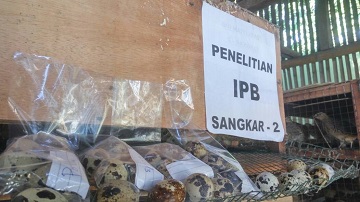A Group of IPB Students Utilized Belimbing Wuluh Juice to Improve the Quality of Quail Eggs

Feed with complete nutritional content is required to produce good quality quail eggs. Nutritional requirements can also be met through the addition of liquid supplements to reduce heat stress and increase productivity. Healthy poultry require a sufficient amount of protein and carbohydrates, along with the necessary vitamins, dietary minerals, and an adequate supply of water. Lactose-fermentation of feed can aid in supplying vitamins and minerals to poultry. Alternative feed supplement, especially natural products is really needed, and Belimbing Wuluh (Averrhoa bilimbi). Carambola has a variety of nutrients, including flavonoids, triterpenoids or steroids, glycosides, proteins, fats, calcium, phosphorus, iron, vitamins A, B1, and C. Vitamin C is an antioxidant that has been proven to counteract stress on chickens that are kept on high temperature.
Averrhoa bilimbi (commonly known as bilimbi, cucumber tree, or tree sorrel is a fruit-bearing tree of the genus Averrhoa, family Oxalidaceae. It is a close relative of carambola tree. A. bilimbi is cultivated primarily for its juicy but very sour edible fruit and for use in traditional medicine. The fruit is used in the preparation of jams and jellies and for cooling beverages. In such cases fruits are pricked or cut into small pieces and steeped in water overnight for reducing sourness and for bringing down the oxalic acid level. Ascorbic acid content in the fresh fruit and fruit juice was found to be 15.42 ± 1.44 mg/100 g and 10.83 ± 0.72 mg/100ml respectively. The content of citric acid in this fruit reaches 92-133 meq acid / 100 g total solids. The citric acid acts as an acidifier. Acidifiers can generally replace the role of antibiotics, improve egg quality, balance the gastrointestinal microflora, increase the absorption of food intestines in the small intestine and increase the benefits.
Seeing the immense possibility, Muhammad Rizqi Ramdhani of Bogor Agricultural University student (IPB) together with his group consist of Nola Okivita Imama, Lylya Wahyuni, Vitya Lana Larasati and Ahmad Rafli Fahmi, uder the sponsorship of Program Kreatifitas Mahasiswa, Penelitian (PKMPE – Student Creativity Program, Research) they proposed to implement the research project on the utilization of . A. bilimbi for Quail farming. This study aims to see the effect of juice of A. bilimbi as drinking water on the quail egg quality. In addition, the study will also determine the proper dosage of A. bilimbi to administered for Quails.
We want to promote bilimbi (Averrhoa bilimbi). We chose these raw materials as natural antibiotics and one of the alternatives for commercial antibiotics. In addition, the vitamin C content of A. bilimbi quite a lot. Intake of vitamin C in cattle can reduce stress levels. Excessive stress will affect the quality of eggs such as not having a shell and others. In addition vitamin C can improve eggshell quality, "said Rizqi as chairman of the group.
The trial was conducted for 30 days of maintenance at Slamet Quail Farm (SQF) farm and 30 days at the IPB Nutrition and Feed Science Laboratory. A. bilimbi juice making was started by washing A. bilimbi then mashed by adding water and blend simultaneously, and filtered finely. A. bilimbi juice then was added to the drinking water of livestock.
"This research method is quite simple, chop A. bilimbi into little pieces and keep it ready for blending, then filtered the juice using cloth. This method is taken aimed to facilitate farmers apply the result of this research. The juice concentration administered for quails was adjusted to the inhibitory test of bacteria, namely 2.5% and 5% concentration," Rizqi explained.
The test was conducted for 42 days using as many as 240 quails (ready to spawn) with four treatments and four replications. Each repetition is kept as many as 15 quails. The treatments were P1 (drinking water + Vitachick), P2 (drinking water + 15% of fruit juice of A. bilimbi), P3 (drinking water + 30% fruit juice of A. bilimbi), and P4 (drinking water + 45% fruit juice of A. bilimbi). The team observed quail performance consisting of feed consumption, egg production and egg mass.
"The development of the parameters is almost the similar to control. This means that so far the treatment provided can be implemented in the community. Productivity that we mean not from the increase in the number of eggs (the quail one day laying only 1 egg, even there are two days). Productivity here is the quality of eggs, such as physical and chemical qualities "concluded Rizqi. (Wied)



